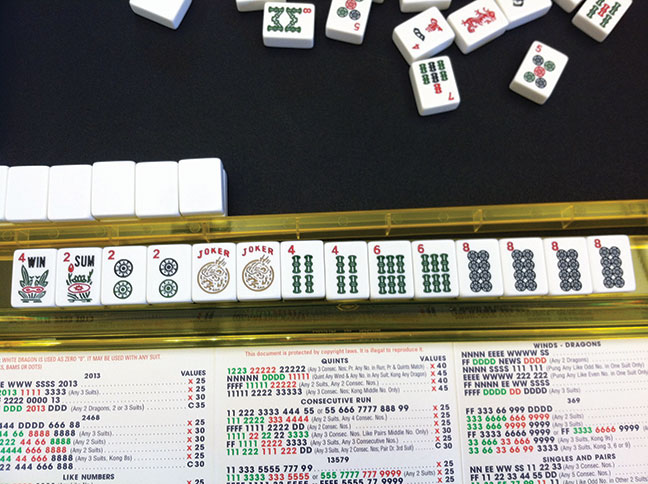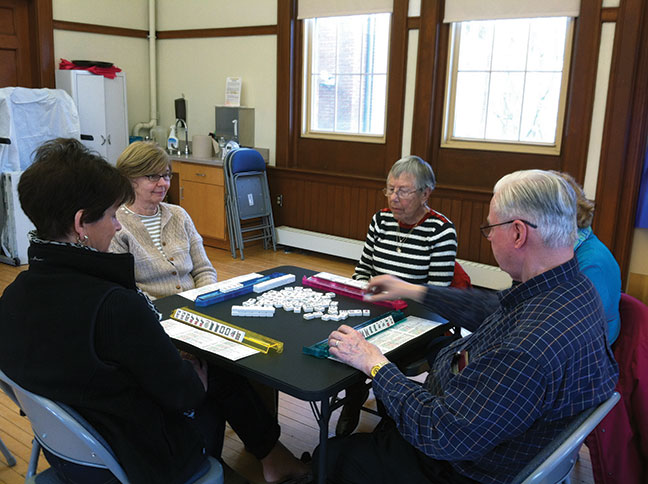For those who work on small community newspapers in little hamlets, villages, and towns, where scouting for tasty bits of text to share with the readership grinds to a halt after Christmas, I feel your pain. There isn’t a reporter out there whose desire to share something interesting isn’t presently thwarted by humanity in hibernation. Yet like a January thaw, yours truly is working hard to bring you a treat you probably didn’t realize you were waiting for – I give you Mahjong!
From Ask.com we find: “Mahjong, a game that originated in China, is commonly played by four players (with some three-player variations found in Korea and Japan). The game and its regional variants is widely played throughout Eastern and South Eastern Asia and has a small following in Western countries. Similar to the Western card game rummy, mahjong is a game of skill, strategy and calculation and involves a degree of chance. In turn players draw and discard tiles until they complete a legal hand using the 14th drawn tile to form four groups (melds) and a pair (head). There are fairly standard rules about how a piece is drawn, stolen from another player and thus melded, the use of simples (numbered tiles) and honors (winds and dragons), the kinds of melds, and the order of dealing and play. However there are many regional variations in the rules; in addition, the scoring system and the minimum hand necessary to win varies significantly based on the local rules being used.” I’m already breathless.
One of the goals of a retired person is to keep one’s brain actively active. I have to admit that my memory and possibly, just possibly, some mental agility may have waned over the last several years. It is disconcerting even when I speak to contemporaries who share that remembering stuff is sometimes a losing battle. So what’s to be done? Why not play games. Game playing is supposed to pump up the mental muscles. Another well understood aspect of staying young, or should I say feeling young while growing older, is being socially involved. That’s where Mahjong can help.
Mattapoisett’s Council on Aging offers a variety of activities including Mahjong. The weekly dives into this complicated game of strategy and chance bear a striking resemblance to high stakes poker. These players take no hostages and are out to win. Caution to the novice who dares to enter the “Mahjong Zone”. While that is precisely what I did, I lived to share my tale. All right, it wasn’t that dramatic but it was certainly complicated, and one quickly felt stupefied by the shear number of moving parts and rules.
Growing up during a time when games in general were a past time in which everyone participated, I learned and played games, but only those the adults in my sphere played. Our games were checkers (both Chinese and standard) and the card game rummy. Over time, I became pretty good. I, in turn, taught my son. He quickly overtook what I had believed was my superior ability. Thus, disabused of that fantasy, I didn’t expect to be able to embrace Mahjong in one session. Oh no, this game will take some time.
Mahjong is ancient – maybe thousands of years – in its evolutionary process and comes from a part of the globe where layers of meaning, layers of language, and layers of subtle inference in all things are common. Just look at your next plate of Chinese food. The colors, textures, combinations are infinite. Look at Asian architecture, especially in China, which is ornate to say the least. So we find that this game, too, enjoys a complexity my simple mind found numbing.
First and foremost, there are the ‘tiles’. After my short time with the COA group, I realized it is the ‘language of the tiles’ that is paramount to understanding the game and learning how to play it. On this afternoon, the players (who have asked me to withhold their last names in the event they have to go into the Mahjong Protection Program) were Sue, Leanore, Linda, Elizabeth, and Bob. The ladies said that Bob was the master, and that he would be the one to answer all my questions about the game. However, it was Linda who suggested to me that in order to learn the game, it helped to study the tiles and play alone at home by yourself. In this way, you can become familiar with the tiles and how to make up a winning hand without slowing down those who have gone before you. Actually, she was very nice about sharing that this was how she taught herself, and the others agreed it had also helped them. I certainly couldn’t have agreed more the longer I observed them.
From the website Rummy.com we find information that is supposed to help explain the game. It states: “Mahjong is very similar to Rummy and is played with tiles. The main objective is to build sets with the tiles through drawing and discarding them. In different variants it has different tiles but it is always played by four players. There is little uniformity in the way Mahjong is played in various provinces in China and it is played in a different way in Hong Kong, Taiwan and Singapore. Traditional Chinese Mahjong is played with 144 tiles (including 8 flower/season tiles) and some variants incorporate just 136 tiles (without flower/season tiles which are optional tiles used to apply bonuses).”
| Tile Name | Tile Type | Duplicates | Number of Designs | Total Tiles |
| Bamboo | Suit | 4 Duplicates | 9 Of Each | 36 Tiles |
| Character | Suit | 4 Duplicates | 9 Of Each | 36 Tiles |
| Circle | Suit | 4 Duplicates | 9 Of Each | 36 Tiles |
| East Wind | Honor | 4 Duplicates | N/A | 4 Tiles |
| West Wind | Honor | 4 Duplicates | N/A | 4 Tiles |
| North Wind | Honor | 4 Duplicates | N/A | 4 Tiles |
| South Wind | Honor | 4 Duplicates | N/A | 4 Tiles |
| Red Dragon | Honor | 4 Duplicates | N/A | 4 Tiles |
| Green Dragon | Honor | 4 Duplicates | N/A | 4 Tiles |
| White Dragon | Honor | 4 Duplicates | N/A | 4 Tiles |
| Flowers | Bonus | 4 Duplicates | N/A | 4 Tiles |
| Seasons | Bonus | 4 Duplicates | N/A | 4 Tiles |
| Total: | 144 tiles |
The tiles go by such shorthand names as Crack (characters), Dots (circles), and Bams (bamboo). The dragons are only called by their colors. Because the white dragon tile looks more like a decorative tiny bar of white soap, it is called Soap. During the discarding of tiles into the center of the table where they may or may not be picked up by another player to help complete their hand, the players are required to call out what they are discarding. Bob explained that this is done because players are so engrossed in their hands they may only be listening and may not notice when a particular tile is being discarded. Got that?
Then there is the prescribed discarding of tiles you don’t want to a player seated either to your right or left. This discarding process is known as ‘turns’ or doing the ‘Charleston’ and requires learning the dance steps. First you discard to the right, then you discard to the left, then you discard to the opposing player, then you step on your own toes. I would have called this a ‘Square Dance’ but what do I know. Anyway, a player could and often does end up with tiles they didn’t want and tried to get rid of. Oh yeah, and it isn’t just one tile; it is a group of tiles.
Then there is ‘the card’. Apparently in the American version of the game, a winning hand game card has been created from which players must pick a specific arrangement of tiles and build their hand to that selection. Unlike rummy, which this game is unfortunately compared against, a player doesn’t get to exercise complete control over a winning hand. A player needs to strike on an arrangement that is approved and allowed by ‘the card’. Confused yet? The National Mahjong League, Inc. produces these cards annually ensuring that no one becomes too comfortable with any specific winning hand. God forbid!
Bob said, “A lot of the rules have been developed to discourage cheating.” Since this is primarily played as a gambling game in the Orient and since it is eons old, the rules are complex and would definitely make cheating at Mahjong an art unto itself.
The COA players have been going strong for a bit over two years now. Long enough for them to have learned not only the game, but also the nuances of each other’s style for building a winning hand. When Sue kept exchanging tiles she had for jokers being held by other players they said, “Oh, she likes that….” While I was there, Sue won twice and Linda won once. Bob shared that when he plays in Florida, that well entrenched group will shun a player who moves through the game slowly. Oh no, those players want to hustle through the game like their Asian counterparts. “If you go too slow, you’ll get boycotted the next time.”
A mahjong set averages around $40. Right now, I’m weighing whether or not I want to invest in a set for home study. I wouldn’t want to force myself on this nice group of people by showing up unprepared. I’m not confident, though. I worry. Do I have what it takes to enter the “Mahjong Zone”? There is honor, there is pride, there is ego to consider. If I fail, would I be able to hold my head up while walking my puppy around town, or will people cross the street when they see me coming? Will they think, “Oh, here comes that woman who doesn’t have the sense to know the difference between a pair and a suit, a bam and a crack.” Just like aging, Mahjong ain’t for sissies. But my weakening synapses just might deserve the chance to prove they’ve still got what it takes – at least for now.
By Marilou Newell

